2022 Kia Sorento PHEV Review: Plugging the Gap

FAST FACTS
| Engine: | 1.6L I4 Turbo |
| Output: | 261 hp, 258 lb-ft |
| Transmission: | 6AT, AWD |
| US fuel economy (MPGe/MPG): | 79/34 |
| CAN fuel economy (Le/100KM / L/100KM): | 3.0/6.9 |
| Starting Price (USD): | $46,405 (inc. dest.) |
| As-Tested Price (USD): | $51,050 (inc. dest.) |
| Starting Price (CAD): | $46,845 (inc. dest.) |
| As-Tested Price (CAD): | $57,095 (inc. dest.) |
A plug-in powertrain makes a lot of sense for Kia’s in-betweener.
Plug-in hybrids are a great compromise between the gas-powered past and the electric future. A stepping stone, if you will, much like the Sorento’s spot in the Kia lineup, a slightly smaller three-row for those who don’t want, need the larger Telluride. (Or don’t want to pay more for a used model than a new one.)
Get a Quote on a New Kia SorentoThe 2022 Kia Sorento PHEV is more than a vehicle of compromise, however. Instead, this accomplished mid-sizer is a four-wheeled example of the old “jack of all trades” adage, but skips over the other part. This is a well-designed, right-sized family crossover that might just be the best one in the Kia family.
What’s new?
For 2022, Kia has added the PHEV variant to the burgeoning Sorento lineup. Like the regular hybrid model, the PHEV employs a turbocharged 1.6-liter four-cylinder, working alongside an 89-horsepower, 224-pound-foot electric motor. The Sorento uses the same six-speed automatic transmission as the regular hybrid too, though the PHEV is AWD-only. The other major change is a larger, 13.8-kWh lithium-ion battery pack. Combined horsepower is up to 261, while torque remains unchanged at 258 lb-ft. Kia quotes an all-electric range of 32 miles (51 kilometers).
Otherwise, not much has changed for the current-generation Sorento’s second year on the market. Every model has the new badge, which works with the angular styling much better than the old one. The truly eagle-eyed will spot the tell-tale charge port aft of the front wheel, and the requisite PHEV badging if they’re close enough. The only real clue otherwise is the set of 19-inch alloys, unique to plug-in Sorentos.
While the gas-only Sorento has half a dozen trims to cater to a broad audience, the hybrid and plug-in hybrid lineup split them up; lower trims for the former, and higher trims for the latter. It’s a practical approach, since a PHEV will carry a higher price premium anyway. But it also opens the doors to a unique interior experience, starting with the very cool blue leather seats.
2022 Kia Sorento PHEV interior and comfort
Yes, you read that right: the Sorento PHEV has optional blue seats, paired with cream leather. It might sound like a lot—and the online configurator gets the color all wrong—but it works well, just subtle enough to blend in on the day-to-day. I’m sure it’d be a constant source of stress for those with messy young ones, so think long and hard before checking this box. For me, it reminds me of the serene Mercedes convertible I tested last fall, and that sort of calming, nautical theme is a welcome one in the frigid winter.
SEE ALSO: Kia Sorento vs Toyota Highlander Hybrid Comparison: Suburban SUV ShowdownThe Sorento’s interior might not be Merc levels of quality, but it feels above-average for its price point. Brushed aluminum vents punctuate the dashboard design, with spars of nicely textured metal breaking up the blue and cream. Aiding the Merc comparo is a subtle bit of ambient lighting tucked into the dashboard, too, and the chunky door handles. If only Kia would dedicate less real estate to the smudge-tastic piano black trim.
Seat comfort is generally good. The front seats boast heat and ventilation, plus the natural light from the huge pano-roof. They’re good on longer road trips, but their flat nature may leave drivers wanting more support. Second-row passengers get heated thrones too, not to mention nearly as much headroom and legroom as up front. The clearest sign this isn’t a premium competitor is the lack of climate control features back here, though.
Third-row space is fine, considering the Sorento’s size. It’s good there’s just the two seats, since headroom comes in at 36.8 inches (935 millimeters) and legroom is a tight 29.6 (752 mm). Thanks to a clever “saddle-shaped” battery pack, nestled between the front seats and around the propshaft, the PHEV has the same cargo space as the regular Sorento. We’re talking a small 12.6 cubic feet (357 liters) with all rows up. Drop the way-backs and we’re talking 45.0 cubic feet (1,274 L); fold the captain’s chairs and now it’s 75.5 cubes (2,138 L) of mostly flat storage space.
SEE ALSO: 2021 Kia Sorento Review: First Drive2022 Kia Sorento PHEV technology and features
As the most expensive 2022 Sorento you can buy, this range-topping tester came loaded with every possible feature. Heat for four of the seats, ventilation for two, a heated steering wheel, good (but not great) 12-speaker Bose sound system, wireless charger, more USB ports than there are seats—it’s a well-stocked space.
A 10.25-inch central touchscreen handles infotainment duty. It’s your standard Kia setup: reasonably quick to respond, though suffers from a font with poor legibility. It also misses out on the wireless Apple CarPlay and Android Auto connectivity of Kia’s smaller 8.0-inch screen. When you do leash up the ol’ phone, CarPlay does use all the real estate, which is nice. Kia has kept physical knobs for volume and tuning, but the capacitive buttons flanking the screen can be troublesome when on the move. The inconsistency in input methods can make it hard to rely on muscle memory.
Another 12.3-inch screen makes its home behind the steering wheel. It’s sharp and affords drivers with all manner of pertinent info, from remaining charge to navigation directions. A head-up display further augments the ground control feel.
SEE ALSO: Kia Sorento vs Honda Pilot Comparison: Three-Row ThrowdownA robust suite of driver assists is standard on all hybrid Sorentos, including forward collision avoidance (with pedestrian detection), blind-spot assist, rear cross-traffic alert, lane departure warning, lane keep assist, driver attention warning, ultra-sonic rear-seat alert, and safe exit assist. Going for this top-shelf PHEV trim also nets a 360-degree camera, Blind View Monitor, improved FCA with cyclist and junction support, and front parking sensors. Kia also throws in its Highway Drive Assist, an adaptive cruise control that is quite natural in action.
2022 Kia Sorento PHEV driving impressions
Strictly by the numbers, you’d expect the PHEV to feel a little lacking in oomph compared to the 2.5-liter turbo. That’s a muscular engine, its 281 hp and 311 lb-ft of torque beating this plug-in by 20 and 53, respectively. But in practice, there’s little between them. The PHEV makes its torque low down, and the thick wedge of torque that the electric motor adds is instantaneous. Throttle response is good, though the system can vacillate between straight electrons or gas assistance when trying to maintain certain highway speeds.
Drivers have the option of forcing the Sorento to run in EV-only mode, alongside Hybrid and Auto, the latter of which cycles between the two others as the system sees fit. We weren’t able to test the estimated 31-mile (52-kilometer) electric range, but short bursts around town suggested it’d come up short. That’s pretty typical for winter driving, however. What we would like more is a dedicated charge-reserve feature, to avoid the system spending precious juice on the highway.
The Sorento rides well, with a flat, positive attitude through corners. Bumps are dispatched without fuss, the Sorento remaining composed over rough terrain and the week’s healthy dump of snow. The mechanical AWD system also allows for more of the drivetrain power to head rearward when needed, the torque vectoring ably doling out the power. Steering weight is as you’d expect: light, but with a consistent level of feedback that makes directing the Sorento super-simple. The brake pedal could use a little more resistance at the top of its travel. On the plus side, the switchover from regenerative to friction braking is natural.
The Sorento PHEV is rated to 79 mpg-equivalent (3.0 L/100 km-equivalent) when factoring in EV travel. Run without plugging in, it’ll do 34 mpg (6.9 L/100 km) combined. Our week saw consumption climb slightly higher, though it was frigidly cold, full of snow, and we never got a full charge. Speaking of, that will take around 10 hours on a regular 110-volt plug, and closer to 3 hours on a 220 outlet.
SEE ALSO: Nissan Pathfinder vs Volkswagen Atlas Comparison2022 Kia Sorento PHEV pricing and competition
You’d think that with the market’s continued love affair for crossovers, and the ever-stricter emissions regulations their makers must adhere to, there’d be more plug-in three-rows. But you’d be wrong.
In fact, there aren’t many plug-in crossovers at all, at least without resorting to premium brands. Mitsubishi will have the renewed Outlander PHEV on offer before year’s end, building off the new model. And then there’s the RAV4 Prime. Beyond that, there are the various HMG plug-ins that share this drivetrain—Tucson, Santa Fe, Sportage—but only this offers a third row.
Nonetheless, true to Kia tradition, the Sorento still represents good value for money. The top SX Prestige trim (or simply SX in Canada, as is the case of this tester) starts at $49,305 ($56,845 CAD), with the only options being premium paint and the panoramic sunroof. Our tester pushes up to $51,050 ($57,095 CAD). That’s Highlander Platinum territory, but with the perk of plug-in power—and the federal and state/provincial rebates that entails. The difference between 2.5-liter turbo and PHEV trims is around $6,900; factor in the EPA-estimated $5,500 in gas savings over five years, and the PHEV would end up costing less than the gas-only model.
Want a lower trim? The plug-in Sorento starts from $46,405 ($46,845 CAD).
SEE ALSO: 2021 Jeep Grand Cherokee L Review: Big Red Sleigh RideVerdict: 2022 Kia Sorento PHEV Review
The 2022 Kia Sorento PHEV only reinforces its position as one of the very best three-rows you can buy. So long as you don’t regularly need to stuff adults into the way-back—or need seven spots—its tidier dimensions make it an easier drive than other three-rows. Being able to run the day’s errands without using fuel is important, too. That it doesn’t feel any tardier than the gas-only model, despite a 50-percent improvement on fuel economy, is a perk.
With smart interior packaging, a smooth ride, and its battery-assisted drivetrain, the Sorento PHEV covers all the bases for a mid-sized family SUV. Skip the Telluride; this is the Kia you should consider instead.
FAQs
How much does the 2022 Kia Sorento PHEV cost?
The starting price for the plug-in is $46,405 in the US, including destination. Canada’s PHEV pricing starts at $46,845 CAD, since it includes a lower trim.
How does the 2022 Kia Sorento PHEV work?
The plug-in hybrid allows owners to drive up to 32 miles (51 km) on electric power alone, and to charge the vehicle at home or at charge stations. When the battery is depleted, the Sorento functions as a regular hybrid.
How long does it take to charge the 2022 Kia Sorento PHEV?
Around 12 hours on a 110-volt outlet; that drops to 2.5 hours for a 220-volt setup.
Become an AutoGuide insider. Get the latest from the automotive world first by subscribing to our newsletter here.
LOVE IT
- Right-sized footprint
- Blue leather interior
- Very "normal" driving experience
LEAVE IT
- Six seats only
- No ability to "store" charge
- Noisy highway operation

Kyle began his automotive obsession before he even started school, courtesy of a remote control Porsche and various LEGO sets. He later studied advertising and graphic design at Humber College, which led him to writing about cars (both real and digital). He is now a proud member of the Automobile Journalists Association of Canada (AJAC), where he was the Journalist of the Year runner-up for 2021.
More by Kyle Patrick



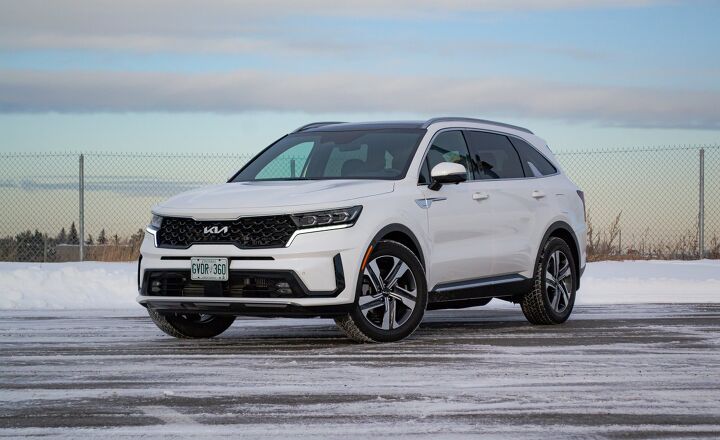





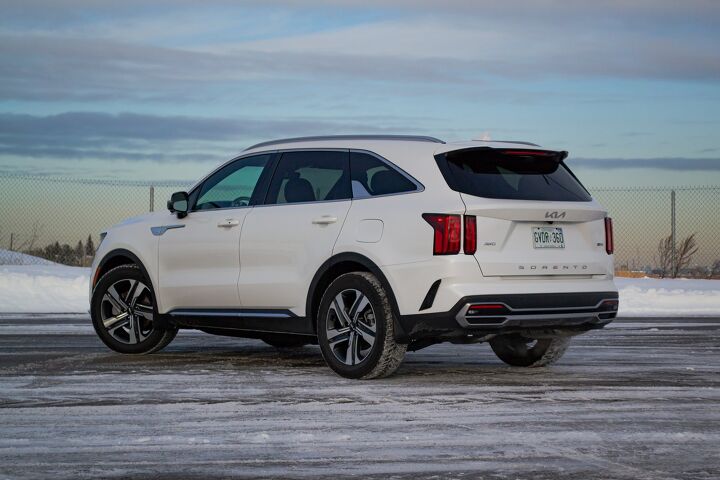


















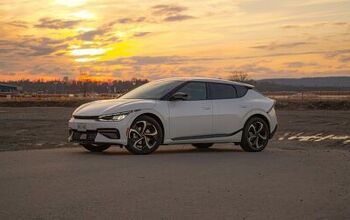
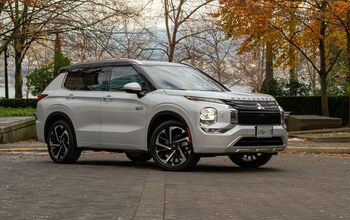
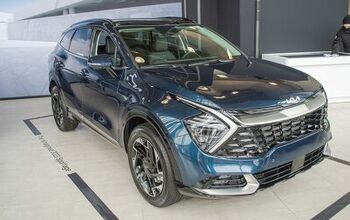


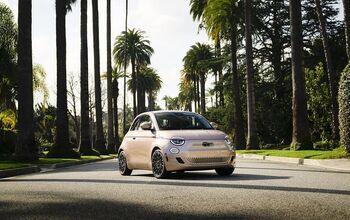

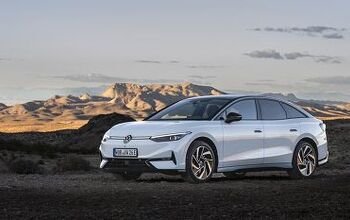

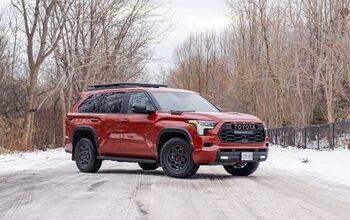


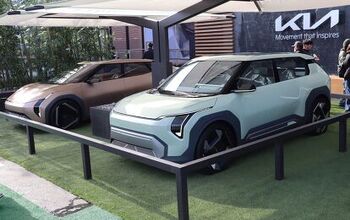
Comments
Join the conversation
Not up to Mercedes level? Mercedes and the other German automakers left true luxury a long time ago. I actually have a Audi A5 convertible and my wife has a Mercedes E350. We just bought a new vehicle so we could have a SUV. We bought the new Mitsubishi Outlander. The Outlander outclassed both the Germans with more standard options. Plus give me a break with the interiors of the Germans. Their is nothing luxury in side. Same hard plastics, cheap looking buttons with the same silk screen lables and mediocre leather that feels the same as the leather in cars costing half the price. That is the end for us! No more cheapness in supposed german luxury cars.